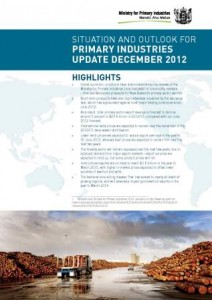 The Government’s Business Growth Agenda progress report on Building Export Markets specifies the target of increasing New Zealand’s exports from 30 percent today to 40 percent of GDP by 2025. It’s a big stretch, says meat industry commentator Allan Barber.
The Government’s Business Growth Agenda progress report on Building Export Markets specifies the target of increasing New Zealand’s exports from 30 percent today to 40 percent of GDP by 2025. It’s a big stretch, says meat industry commentator Allan Barber.
The progress report states that primary sector exports have outpaced the rest of the export sector, growing by half in real terms since 2000 at an average productivity growth rate of 2.1 percent per annum. To achieve the target of 40 percent of GDP, agriculture will have to maintain its growth rate for the next 13 years, while the rest of the economy must lift its game considerably. Manufacturing and services have been increasing by one percent a year and need to lift this to five percent over the coming decade, or alternatively agriculture will be required to expand further to bridge the gap.
This is an enormous challenge, equivalent to creating 250 more knowledge-intensive businesses creating $100 million from exports a year. The report cites Navman as an example of the type of business required. How many more like this can we think of? Not many, so it is highly improbable that these new businesses will emerge from areas totally unconnected with agriculture.
Primary sector exports will therefore have to increase by quite a bit more than the average of the past decade, if the target as a whole is to be reached.
Using a different report and set of figures the Riddet Institute in its recent Call to Arms report challenged the primary sector to treble its exports to $60 billion by 2025, equivalent to New Zealand’s total exports of goods and services today. However exports of $20 billion are only one third of the total. These figures emanate from the Government’s Economic Growth Agenda.
We can quibble with the different measurements and totals used to arrive at the conclusions (GDP, total exports, growth rates), but the fact remains, it’s one hell of a big stretch to see how to reach the target. The goal of the Boot Camp taking place at Stanford University this week is to see whether like-minded companies can develop the strategies required to bring agriculture up the value chain, enabling the sort of increase envisaged.
The question is whether the Government’s progress report on the activities of the Business Growth Agenda will contribute to the big goal and, if so, how significantly. It is a big ask, because it demands growth of between 5.5 percent and 7.5 percent, depending on the economic growth path, compared with Treasury’s forecast for the next three years of 1.8 percent.
The report says with a degree of understatement that “to achieve our target will require a concerted effort to develop more internationally competitive businesses in both the commodity and high-value technology-based sectors.” This may be official speak for ‘we know we haven’t got a hope, but we have to start somewhere.’
The key planks of the export growth development strategy are: Delivering a Compelling New Zealand Story; Improving Access to International Markets; Increasing Value from Tourism; Making it Easier to Trade from New Zealand; Growing International Education; Helping Businesses Internationalise; and Strengthening High-Value Manufacturing and Services Exports.
The progress report finishes with a summary of the strategies under each of these headings and Progress Indicators listing detailed actions underpinning the strategies. There is an enormous amount of work going on, notably in trade negotiations, removal of red tape for business, trade missions into key markets and tourism developments such as SmartGate at the airport.
But all work on developing a compelling New Zealand story is listed as a new project which indicates one of the major problems encountered in lifting our exports as a percentage of GDP. There is no agreed brand image under which all New Zealand’s exports and tourism experiences are promoted. The meat industry’s main brand has for a long time been New Zealand Lamb which has been very successful, but a major complaint has been the competition in export markets between exporters. Apart from North America, cooperation has been seriously lacking.
Part of the problem has been the complete lack of a generic New Zealand brand image. Development of this with a believable and compelling story to back it is an absolute priority, because brands take a long time or a lot of money to gain awareness, probably both.
This progress report is the first of six with the other five to come being Innovation, Skilled and Safe Workplaces, Infrastructure, Natural Resources and Capital Markets. Obviously these other areas will play an important role in achieving the export goal.
The Government deserves credit for coming up with a coherent strategy, but it will have to generate a tremendous response from the private sector if the goal is to come close to being realised. Another challenge is the high proportion of SMEs in New Zealand which must be inspired to pursue the new business opportunities capable of converting them into large businesses with the requisite scale.
This article has also appeared at interest.co.nz.
 New Zealand’s meat processors and farmers can expect lower lamb prices over the remainder of the 2012/2013 production season, while beef prices are expected to remain firm over the next two years, says the Ministry of Primary Industries (MPI).
New Zealand’s meat processors and farmers can expect lower lamb prices over the remainder of the 2012/2013 production season, while beef prices are expected to remain firm over the next two years, says the Ministry of Primary Industries (MPI).
